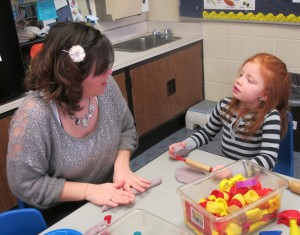How Many Kids Would Take Advantage Of A Voucher-Style Pre-K Program?

Elle Moxley / StateImpact Indiana
A Head Start classroom aide asks a student to make shapes in her play dough.
Roughly 40,000 low-income Hoosier 4-year-olds would qualify for preschool vouchers each year under the proposal Gov. Mike Pence wants state lawmakers to approve in 2014.
But as StateImpact readers pointed out after we did some back-of-the-napkin math, not all eligible families are likely to participate.
So we asked: How many would?
“My best guess would be 40 to 50 percent,” Brookings Institute fellow Russ Whitehurst tells StateImpact.
Whitehurst, who researches early learning at Brookings’ Brown Center of Education Policy, says he’s basing his estimate on enrollment of low-income families in Georgia’s universal pre-K program.
The pro-voucher Friedman Foundation also pointed us towards two universal programs when we asked about participation in state-funded pre-K:
- Florida’s Voluntary Pre-Kindergarten program is serving 172,227 students, or about 78 percent of 4-year-olds in the state. Participation has been relatively stable for the past four years. Nearly half of eligible kids enrolled in the program’s first year.
- Participation in the Denver Preschool Program has stabilized at around 69 percent since the initiative began five years ago. Parents pay on a sliding scale based on income.
Of course, the biggest question is still how to fund Pence’s proposal. Even with broad support for preschool, it’s unclear if Indiana can pay for it in a non-budget year.
So considering this range of participation — from half of all eligible low-income kids in Georgia to roughly four of every five eligible kids in Florida — let’s update our math:
On the low end, a pre-K voucher program would cost around $50 million per year. On the high end, a pre-K voucher program would cost around $100 million per year.
As we’ve mentioned previously, Pence prefers a “targeted” program — one focusing on families making less than 185 percent of the federal poverty level, the same students who are eligible for K-12 vouchers.
“I think that Indiana is doing the right thing in providing a voucher program that is targeted on low-income kids rather than taking whatever the available pot of money is and spreading it thin,” says Whitehurst.
Whitehurst says the vast majority of state-funded pre-K programs have some voucher element, relying on a mix of both public and private providers to enroll eligible students. He also offered the same words of caution about quality we’ve heard from early learning advocates.


